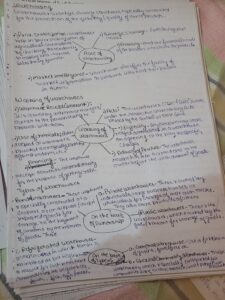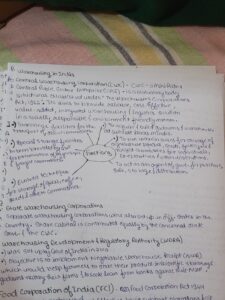Mains Answer Writing Latest Questions
Analyze the policy and investment goals in this area and discuss the role that agri-logistics infrastructure—such as cold storage facilities, transportation networks, and warehousing—plays in lowering post-harvest losses and improving farmers’ access to markets.
-
Designing an efficient farm layout involves several key factors: Land Topography: Consider the natural landscape to optimize water flow and prevent erosion. Soil Quality: Assess soil types and fertility to determine the best crops and placement. Water Resources: Efficient irrigation systems and propRead more
Designing an efficient farm layout involves several key factors:
- Land Topography: Consider the natural landscape to optimize water flow and prevent erosion.
- Soil Quality: Assess soil types and fertility to determine the best crops and placement.
- Water Resources: Efficient irrigation systems and proper placement of water sources are crucial.
- Crop Rotation and Diversity: Implementing crop rotation and diversification to improve soil health and reduce pest issues.
- Accessibility: Design paths and roads for easy access to fields, machinery, and storage.
- Climate Considerations: Plan layout based on local climate conditions to maximize growth periods and protect crops from adverse weather.
- Sustainability Practices: Incorporate practices like composting areas, and renewable energy sources, and use organic farming methods to enhance sustainability.
These factors ensure the farm operates efficiently, sustainably, and productively.
See less
Assess the effectiveness and integrity of the resource management system by evaluating the government’s initiatives to improve the accountability and transparency of resource mobilization and utilization, such as the establishment of the Goods and Services Tax Network (GSTN), the bolstering ...
-
The Government of India has introduced several strategies to enhance the transparency and accountability of resource mobilization and utilization, aiming to improve the efficiency and integrity of the resource management system. Let's evaluate the key initiatives and assess their impact: Goods and SRead more
The Government of India has introduced several strategies to enhance the transparency and accountability of resource mobilization and utilization, aiming to improve the efficiency and integrity of the resource management system. Let’s evaluate the key initiatives and assess their impact:
- Goods and Services Tax Network (GSTN):
- The implementation of the Goods and Services Tax (GST) and the establishment of the GSTN have revolutionized the indirect tax system in the country.
- GSTN is a technology platform that facilitates the seamless flow of information and data related to GST, enabling real-time tracking and monitoring of transactions.
- Impact: The GSTN has improved tax compliance, reduced tax evasion, and enhanced the transparency of the indirect tax system. It has also facilitated the efficient collection and distribution of GST revenues among the central and state governments.
- Strengthening of the Public Financial Management System (PFMS):
- The PFMS is a web-based application that provides end-to-end solutions for processing payments, tracking, monitoring, and accounting of funds across multiple government schemes and programs.
- The government has been continuously upgrading and expanding the PFMS to enhance its coverage and functionalities, ensuring greater transparency and accountability in the utilization of public funds.
- Impact: The PFMS has improved the tracking and monitoring of fund utilization, reduced leakages, and enabled real-time reconciliation of accounts. This has led to better financial management, improved efficiency in the delivery of public services, and enhanced transparency in the use of public resources.
- Digital Platforms for Public Service Delivery:
- The government has invested heavily in the development of digital platforms and e-governance initiatives to improve the delivery of public services and enhance transparency.
- Examples include the Unified Payments Interface (UPI) for digital payments, the Aadhaar biometric identification system, and the integration of various government services through platforms like the DigiLocker and the National Portal of India.
- Impact: The adoption of digital platforms has increased the accessibility and efficiency of public service delivery, reduced opportunities for corruption, and enhanced the transparency and accountability of government operations. It has also facilitated better targeting and delivery of government schemes and subsidies to the intended beneficiaries.
Overall Impact on Improving the Efficiency and Integrity of the Resource Management System:
The government’s strategies to enhance the transparency and accountability of resource mobilization and utilization have had a significant impact on improving the efficiency and integrity of the resource management system:- Increased Tax Compliance and Revenue Generation: The implementation of the GSTN has led to improved tax compliance, reduced tax evasion, and increased tax revenue generation, strengthening the government’s resource mobilization capabilities.
- Efficient Fund Utilization and Reduced Leakages: The strengthening of the PFMS and the adoption of digital platforms have improved the tracking, monitoring, and accounting of public funds, leading to better resource management and reduced leakages in the delivery of government schemes and services.
- Improved Transparency and Accountability: The use of digital platforms, real-time data integration, and enhanced information sharing have increased the transparency and accountability of government operations, building public trust and confidence in the resource management system.
- Effective Targeting and Delivery of Subsidies and Benefits: The integration of digital platforms and biometric identification systems has enabled the government to better target and deliver subsidies and benefits to the intended beneficiaries, ensuring the efficient utilization of public resources.
While these initiatives have had a positive impact, the government needs to continue to refine and expand these strategies, address the remaining challenges, and ensure their sustained implementation to further enhance the efficiency, integrity, and overall effectiveness of the resource management system.
See less - Goods and Services Tax Network (GSTN):
What are the key regulations governing the banking sector in India?
-
Key laws governing Indian banking: 1. Reserve Bank of India Act, 1934: Allows RBI to set up RBI control over the direction of a monetary policy, exercises powers to supervising the direction of banks and keep aproper check on monetary operation hence making it a central authority. 2. Banking RegulatRead more
Key laws governing Indian banking:
1. Reserve Bank of India Act, 1934:
Allows RBI to set up RBI control over the direction of a monetary policy, exercises powers to supervising the direction of banks and keep aproper check on monetary operation hence making it a central authority.
2. Banking Regulation Act 1949:
It provides direction on issues to do with licensing of banks, capital, structure and management and operations, including aspects on mergers and acquisitions.
3. Prevention of Money Laundering Act, 2002:
The Act strictly compels banks to adhere to AML and KYC standards besides closely observing transactions which they find suspicious;vi and reporting such transactions to the Financial Intelligence Unit-India (FIU-IND).
4. Basel III Norms:
The implementation of international standards is achieved when RBI asks the banks to maintain specific capital and liquidity ratio that would eventually minimize the probability of the spread of systemic risk and boost resilience.
5. Insolvency and Bankruptcy Code (IBC), 2016:
There has been also clear working out of mechanism for recovery of credits which also help in default resolution of banks and has also ensured strict compliance of credit discipline of the borrowers.
6. Negotiable Instruments Act, 1881:
Deals with safe, transparent and courteous way at the back office management of financial instruments such as cheque, bearer cheque, bill and bearer bill and helps to ensure integrity of electronic transactions.
See less
How do different monetary policy frameworks such as inflation targeting or flexible exchange rate regimes ,compare in terms of their advantages and drawbacks ?
a disaster on india’s traditionl economy demolition of artisians craftsmen introdution of new landlord system poor situation of agriculture
-
Colonial rule in India was very bad for the traditional economy. It hurt artisans and craftsmen, brought in new landlords who made farming hard, and made agriculture poor.
Colonial rule in India was very bad for the traditional economy. It hurt artisans and craftsmen, brought in new landlords who made farming hard, and made agriculture poor.
See less



Farm subsidy is a financial support provided by the government to farmers and agricultural producers in order to enhance farm productivity, incentivise adoption of sustainable agricultural techniques, thus supplementing their income, ensuring food security and agricultural development in the countryRead more
Farm subsidy is a financial support provided by the government to farmers and agricultural producers in order to enhance farm productivity, incentivise adoption of sustainable agricultural techniques, thus supplementing their income, ensuring food security and agricultural development in the country. It was introduced back in 1964 in India and at present, the total subsidy offered to farmers is 2% of our GDP.
Farm subsidies can be broadly divided in two categories:
Impact of Farm Subsidies on Farmers:
Farm subsidies have both the positive and negative impact on farmer’s lives. Let’s have a look into each of these one by one:
Positive Impact:
Negative Impact:
In India, more than 60% of the population is involved in agricultural and allied activities which contributes to a staggering 18 – 19% of total GDP which reflects our systemic failure in providing farmers with better income opportunities. Farm subsidies are definitely a good tool to assist them in escalating their earning curve with higher production, easy availability of credit for new investments and proper training and skill development programs. Proper targeting of direct subsidies, reduced corruption and uniform infrastructural development in all regions will raise the earning bars for marginalized farmers and improve their living standards. It is only with the proper employment of available human and physical resources we can achieve our target for an equitable development and growth of the nation.
See less